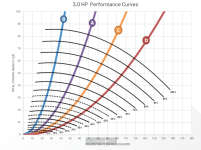- Apr 21, 2020
- 1,554
- Pool Size
- 22000
- Surface
- Fiberglass
- Chlorine
- Salt Water Generator
- SWG Type
- Pentair iChlor 30
The general theme for VSP here is to get the largest size you can. Often that means get the 3HP pump over the 1.5HP pump. What sort of limitation on your system (piping, other equipment like filters and heater) prevents you from getting a 3HP pump?
The reason for the above question is that I am working with my pool company to replace my current pump with pump that can pump at a higher volume for a particular RPM. I said I'd like to go to a 3HP pump. Pool guy said there's a reason they installed a 1.5HP pump on your pool. He doesn't know what the piping looks like underground and the equipment installed so he's reluctant to go much larger. He's suggesting a Hayward Tristar 1.85HP.
The things is that all the piping is 2" PVC. The sand filter is Pentair SD80, one of its largest. The heater is a Pentair Mastertemp 400. Current SWG is the iChlor 30 but will be replaced as soon as possible since it is non-functioning. Where would the limitation be on my system to prevent a larger pump?
The reason for the above question is that I am working with my pool company to replace my current pump with pump that can pump at a higher volume for a particular RPM. I said I'd like to go to a 3HP pump. Pool guy said there's a reason they installed a 1.5HP pump on your pool. He doesn't know what the piping looks like underground and the equipment installed so he's reluctant to go much larger. He's suggesting a Hayward Tristar 1.85HP.
The things is that all the piping is 2" PVC. The sand filter is Pentair SD80, one of its largest. The heater is a Pentair Mastertemp 400. Current SWG is the iChlor 30 but will be replaced as soon as possible since it is non-functioning. Where would the limitation be on my system to prevent a larger pump?







